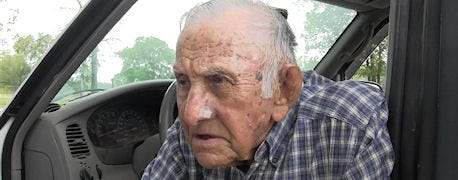February 26, 2014

One of the geniuses of Gordon Hazard's 60-year-old, started-from-scratch beef operation is his money management.
Hazard has always counseled people who want to build a beef business this way: Make your living outside your beef business, make it profitable and keep pouring the profits back into expansion.
Hazard, who is now 90, started in the business when he was on leave from the Army during World War II. While on leave he found a piece of land to buy near his home in West Point, Mississippi, decided he could easily cover the payments with his monthly salary, bought the place against the banker's advice, and went back to Europe.

Gordon Hazard Talks Money Management In Beef Production
He survived the war, later went to vet school and then made his living as a veterinarian. He and wife Sarah raised and educated four children on his veterinarian's income and Hazard kept growing his business, all in his "spare" time and always investing profits from the beef operation back into ... the beef operation.
When Beef Producer visited the Hazards last July we watched them move one group of 500 steers in less than an hour. All their cattle are owned and all are moved on a three-day rotation in the summer growing season and are basically set-stocked on fescue in the winter.
That's about it," Hazard said at the end of the move. "It takes us two hours or less each day to take care of the cattle."
The only exception is receiving and shipping time.
Nearly all other management needs Hazard pays for out of profits on the cattle: Mowing, fence building, corral building and repairs, occasional day labor. He says minimizing owned equipment and labor is one of his money management secrets.
For simplicity, the Hazards have set up their grazing so different groups are moved each day. Commonly, Gordon opens the gate and calls them and elder son Mark, a retired bank president, pushes the tail-enders, if necessary, with a UTV. If there are no new calves on the property they may not need to be pushed. Then both men go about the rest of their day's business.
Some of Hazard's ideas have been well copied by the beef industry but most have not. Yet his 60-year record of success seems to beg inquiry. Here are some of Hazard's key principles.
Keep reading after the jump.
~~~PAGE_BREAK_HERE~~~
No debt. In his book Hazard says he grew up in the depression and watched his father lose everything to debt by farming and have to start over. He says that's when he learned to hate debt and plows. "I knew debt would take the farm and if you plowed long enough you would accumulate debt." Further, he says, economies cycle and bad times will always come around again. That's when debt will take you down.
Use sell-buy accounting. Buy the cattle with your own money, Hazard says. Then count your profit as the difference between the calves you sell and those you buy back. Forget about the money you put in. It's collateral, working capital. It's now cattle. Do a good job selling and re-buying in the same market and you'll have a profit margin. Ownership is the key. "When you own the cattle, it is nearly impossible to go broke," he says.
No depreciation. Part of Hazard's no-debt policy is fulfilled by not owning depreciable equipment. He doesn't like anything that rusts. He doesn't own cows.
He buys no hay and feeds no hay.
He hires out any mowing of pastures he needs. He hires work done with equipment because it saves valuable working capital. It also helps your neighbors who own equipment. Perhaps most important, his mantra is to keep his money working, growing and turning over.
Cheap gains. Hazard says good grass and minimum feed has always provided the cheapest gains. He was one of the earliest to develop successful rotational grazing program, which is the basis for good production and for attaining further production efficiencies. All perennials and no annuals.
Hazard says to make profit such a central part of your thinking that it becomes painful to spend a dollar. At the same time, he says to always keep in mind you can't starve a profit out of a steer. "In summation, grass is what we're selling."
Run the right cattle. Hazard has long favored steers versus heifers for their higher rate of gain. You're selling pounds, after all. He also favors plainer cattle such as 1 1/2 Okies, that he can "upgrade," not just put weight on. Further, he prefers to buy them pretty light and keep them a long time. That just makes sense, he says, since conditioning is the biggest cost you put into stocker cattle, other than purchase price.
TLC. Practice good receiving, handling, loading. Establish good receiving protocols and knowledge of receiving -- usually a strength of modern stocker operations. Use low-stress handling from beginning until steers leave on the truck. Grazing management helps with this. Use a lead steer to teach new arrivals the system.
Market well. When it's time to sell, of course it's always better to sell potloads. Beyond that, Hazard says you should never ask the buyer what he'll give. The cattle belong to you; you have the right to ask a fair price, set the time of delivery and suggest reasonable shrink in the deal. Further, Hazard is known for loading every ethical pound possible on the trucks on shipping day by giving the animals some grazing time early in the morning, keeping them very calm and still loading them quickly.
Most of Gordon Hazard's favorite advice is dispensed in his book, Thoughts and Advice from an Old Cattleman, available from [email protected].
You May Also Like




